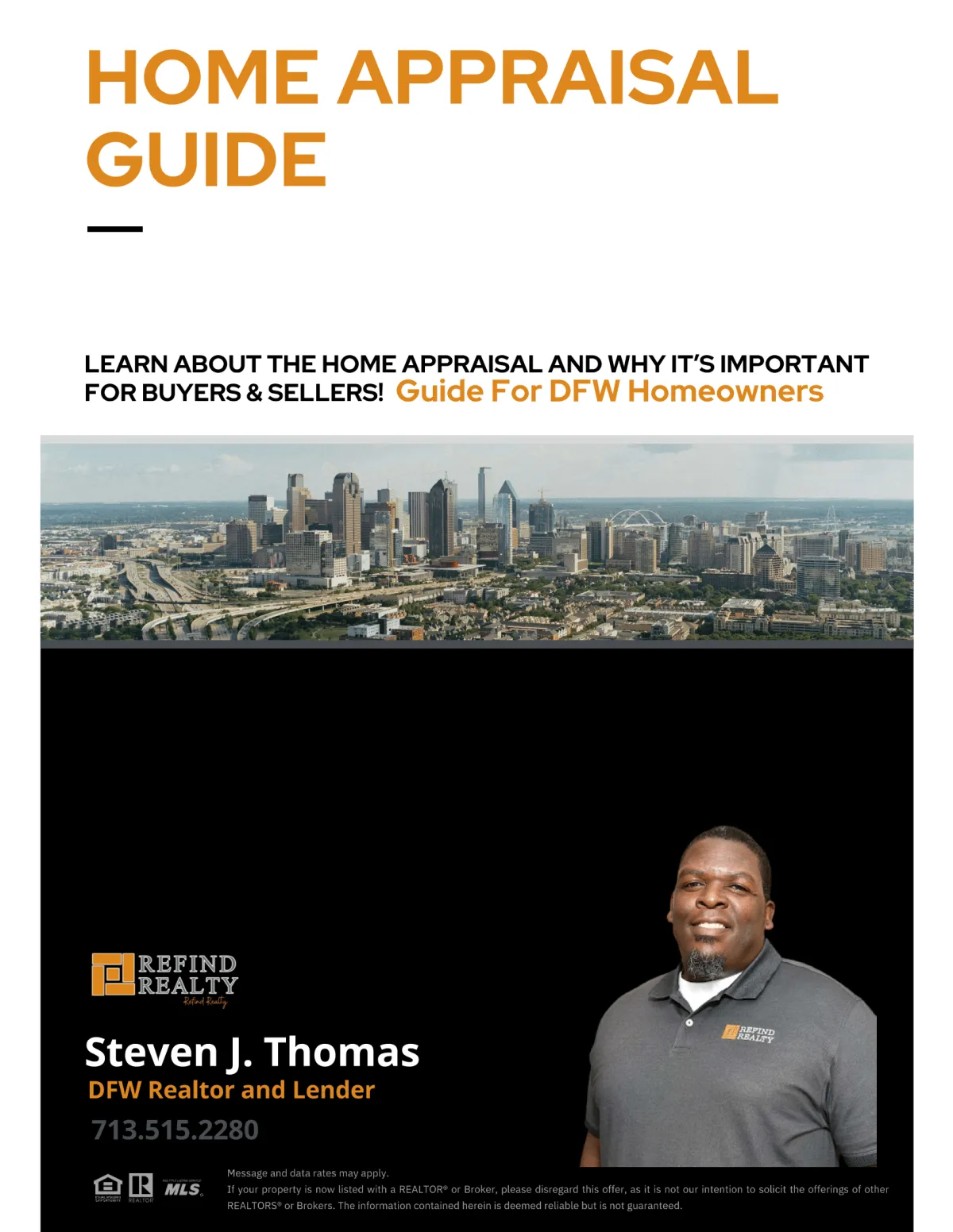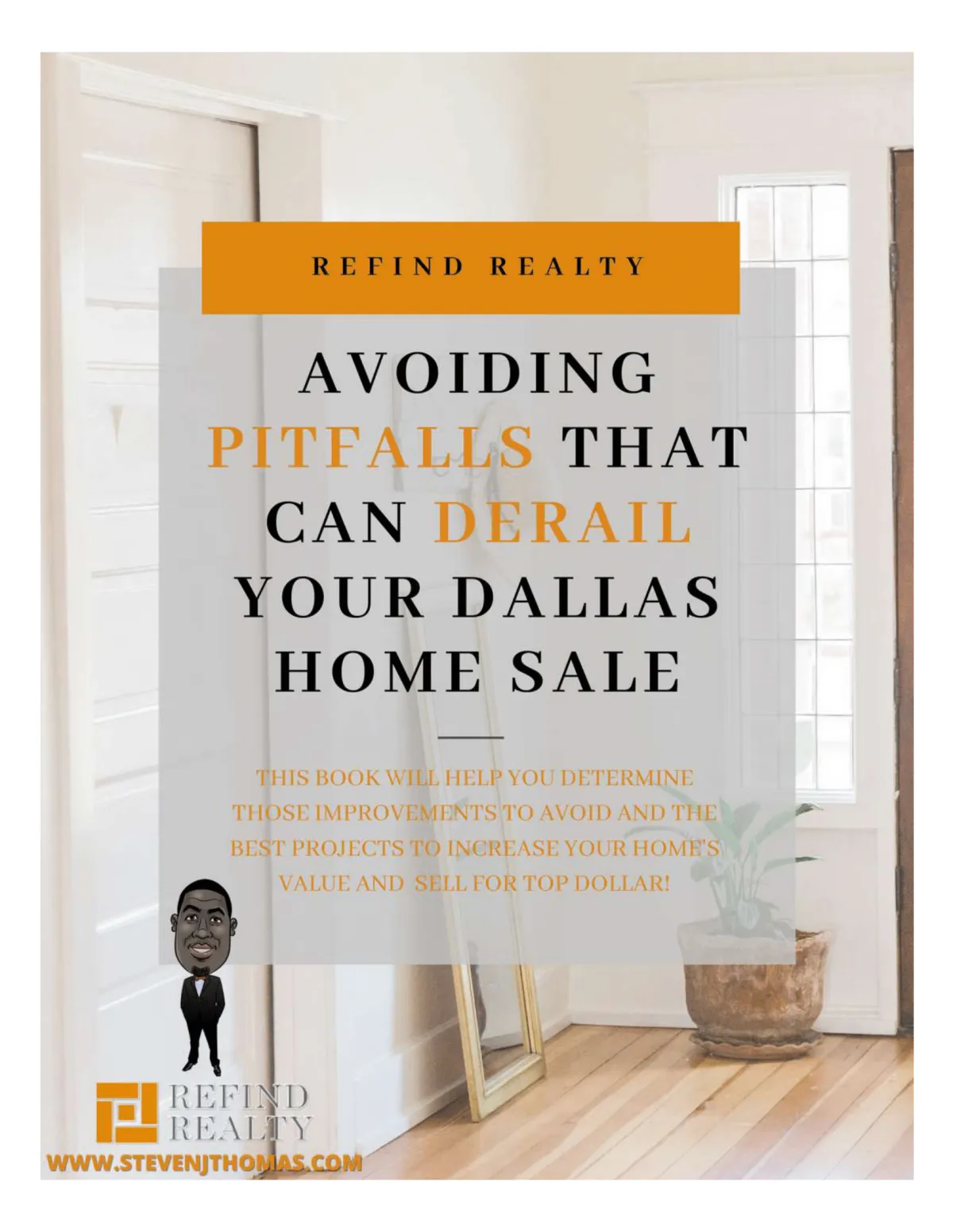You're Always At Home With Refind Realty.
Serving Your DFW Real Estate Needs Since 2005.
We Help You Buy and Sell in The Greater Dallas-Fort Worth Area.
Check Out Our Social Media Channels!
Buying in DFW
Buying your first or next home should be a rewarding and exciting time in your life, and one that you look back on with fond memories.
Thinking Of selling?
The market has changed a lot and I'd love to show you the exact strategy I use to get sellers in DFW top dollar for their property.
Get Pre-Approved
Let me walk you through the entire pre-approval process so you know exactly how much home you can afford.
Sign Up For my
Email List
My emails are a great way to stay up-to-date with local news and real estate market trends, even if you're not currently in the market. So, come on and join me to stay in the loop!
affordability Calculator
Get pre-approved to know exactly how much house you can afford. Use this calculator to get a quick estimate. Contact me for assistance!
DFW New Construction
Discover the latest new home constructions in DFW and take advantage of the builder incentives that are available now.


Owned and Operated by Thomas & Thomas Financial Group, LLC
Let's Make Your real estate Dreams Come True.
Newest Listings
Call Me Today At (713) 505-2280

Refind Realty Blog:


What to Know Before Moving to Dallas/Fort Worth from Out of State
What to Know Before Moving to Dallas/Fort Worth from Out of State
By Steven J. Thomas

Direct Answer
If you’re moving to Dallas–Fort Worth from another state, expect strong job growth, affordable housing compared to coastal cities, and a region built on convenience, community, and opportunity.
But success here starts with preparation — understanding neighborhoods, cost of living, weather, property taxes, schools, and commute patterns before you move can save you time, money, and stress.
1. The Dallas–Fort Worth Metroplex Is Huge
The DFW metroplex spans over 9,000 square miles — larger than the entire state of Massachusetts.
It’s made up of two major urban centers (Dallas and Fort Worth) and dozens of surrounding cities and suburbs. Each has its own housing style, school districts, and lifestyle vibe.
Popular relocation areas include:
North Dallas & Collin County – Frisco, Prosper, McKinney, Plano
Southern Dallas Suburbs – DeSoto, Cedar Hill, Red Oak, Midlothian
Tarrant County – Arlington, Mansfield, Southlake, Keller
Western Corridor – Fort Worth, Aledo, Benbrook
📍 Explore homes by city: DFW Homes for Sale
2. Cost of Living: Still Affordable, but Rising
Compared to California, New York, and Illinois, DFW remains 30–50% more affordable for housing — but costs are increasing as demand grows.
CategoryDFW AverageCompared to National AverageHousing95% of U.S. average✅ LowerUtilities101%⚖️ AverageGroceries99%⚖️ AverageTransportation96%✅ LowerProperty TaxesHigher than national average🚨 Plan Ahead
💡 Tip: Property taxes in Texas can range from 2.0%–3.4% of assessed value annually — but there’s no state income tax, which offsets the difference for many households.
3. Expect Hot Summers, Mild Winters
Dallas–Fort Worth has a humid subtropical climate:
Summers: 90–105°F (June–September)
Winters: 40–65°F (December–February)
Occasional spring storms and mild winter freezes
Newer homes are built for energy efficiency, but if you’re moving from a cooler state, prepare for higher summer electric bills.
☀️ Tip: Ask about radiant barriers, attic ventilation, and SEER ratings when shopping for new construction.
4. The Job Market Is Booming
DFW ranks among the top 3 U.S. metros for job growth, adding over 120,000 jobs annually across finance, tech, logistics, and healthcare.
Major employers include:
Goldman Sachs (Downtown Dallas)
Wells Fargo & Caterpillar (Irving–Las Colinas)
Toyota North America (Plano)
Amazon, Meta, and Bell Textron (Fort Worth)
This steady growth fuels both housing demand and price appreciation, especially in emerging suburbs.
💼 More on this trend: The Effect of Big Employers Moving to DFW
5. Schools Matter — Even If You Don’t Have Kids
School ratings directly affect home values and resale demand.
Top-performing districts in the region include:
Frisco ISD (A+)
Allen ISD (A+)
Midlothian ISD (A)
Cedar Hill Collegiate (A)
Use TEA accountability ratings and tools like greatschools.org to compare campuses.
If you’re buying new construction, ask which future schools are zoned for your community — boundaries change often.
6. Housing Options for Every Lifestyle
DFW offers a wide range of housing types:
Buyer TypeRecommended AreaWhy It WorksFirst-Time BuyersForney, Red Oak, AubreyAffordable new builds under $400KFamiliesFrisco, Midlothian, MansfieldTop schools, newer master-planned communitiesLuxury BuyersSouthlake, Prosper, ColleyvilleCustom estates, gated neighborhoodsEmpty NestersWaxahachie, AledoPeaceful suburbs with quick city access
🏡 View curated new construction listings: DFW New Construction Homes
7. Traffic Is Manageable — If You Choose the Right Location
DFW’s road system is massive, with multiple loops (I-20, I-30, I-35, 635, George Bush Turnpike).
Commutes vary widely:
Live 10 miles from work: 15–20 minutes.
Live 30 miles away: 45–60 minutes during rush hour.
Plan your move based on where you’ll work or where your kids will go to school — not just the home itself.
8. Property Taxes, Utilities, and HOAs
Texas doesn’t have state income tax, but property taxes can feel steep for newcomers.
Average property tax rate: 2.3%–3.2% of assessed value.
Most suburban new builds include HOA fees ($300–$1,000/year) covering amenities and maintenance.
💡 Tip: I provide clients with true monthly cost estimates (mortgage + taxes + HOA + utilities) before writing any offer — so there are no surprises after closing.
9. Buying vs. Renting
While rents are still relatively affordable, homeownership builds equity fast in DFW’s appreciating market.
In 2025:
Average DFW home price: $430,000
5-year appreciation rate: +39%
Average rent for 3-bed home: $2,350/month
If you’re staying 3+ years, buying often makes more sense — especially with new build incentives and rate buydowns available now.
10. Work With a Local Agent Who Understands Both Real Estate and Lending
Relocating from out of state means juggling financing, logistics, and timing.
You need a local professional who can:
Align your loan pre-approval with builder timelines
Coordinate remote showings and virtual tours
Handle new construction walkthroughs and inspections on your behalf
As both a Realtor® and Loan Officer, I streamline your relocation — from property search to loan structure — so your transition to DFW is smooth and predictable.
📅 Book Your Home Goals Consultation
Conclusion
Moving to Dallas–Fort Worth offers career growth, affordable living, and diverse communities — but understanding the market ahead of time is key.
From property taxes to traffic routes and school zones, small details make a big difference in your experience and resale value.
Whether you’re relocating for work, family, or lifestyle, I’ll help you make your move to DFW seamless — with clear numbers, smart timing, and local expertise.
🏡 Explore DFW New Construction Homes
📈 Get Pre-Approved Today
📅 Schedule a Home Goals Consultation
Key Takeaways
DFW offers strong job growth, affordable housing, and no state income tax.
Property taxes are higher but balanced by lower overall cost of living.
Research school districts and commute times before choosing a suburb.
Consider new construction for better energy efficiency and incentives.
Work with a local agent–lender who understands relocation logistics.
Stay Informed With My Downloadable
Buyer and Seller guides

6 Smart Ways to Build Home Equity

7 Insider Secrets To Selling Your Home w/o a Lot of Time or Money

DFW Home Seller Negotiation Secrets

Home Appraisals Guide

Avoiding Pitfalls That Can Derail Your Home's Sale

Ultimate Guide To Buying a Home

A First Time Homebuyers Guide In DFW

Are You Ready To Buy?

25 Insider Secrets To Buying A Home

How to Improve Your Credit
Download All My Guides For Free


Owned and Operated by Thomas & Thomas Financial Group, LLC
Steven J. Thomas
Steven J. Thomas has been in the financial services industry for the past 19 years and started my career as a Financial Planner for American Express Financial Advisors. I entered into banking with JP Morgan Chase as personal banker in 2003 and was promoted several times up to Small Business Specialist. I earned multiple Million Dollar Club awards and was ranked in the top 5 Small Business Specialist before I branched out in 2005 to start my own Financial Management Company. I ran a successful company before family circumstances lead me to Wachovia Bank in 2008 where I worked as a Senior Financial Specialist. As a Sr. Financial Specialist; I was responsible for the P & L and revenue growth of my banking center. The elimination of my role thru a bank merger lead me to BBVA Compass. I have held various leadership roles at BBVA Compass including Personal Relationship Manager, Branch Retail Executive, Workplace Solutions VP, and his current role as a Retail Manager. As the Regional Workplace Solutions VP, I was responsible for the strategic, tactical, and execution of Partnership Banking relationships, promotion and activity with corporate and non-profit companies in my footprint. I was responsible for the acquisition production for three districts, which includes 51 banking centers and over 300 employees. In May of 2014, I joined the team at Refind Realty and became one of the managing partners in mid-2015.

Wondering What Your DFW Home Could Be Worth in 2025?
Get a Professional Home Valuation From A Local Market Expert
Unlock insights into potential selling prices.
Get a personalized analysis sent directly to your inbox.
Stay ahead with updates on property value fluctuations.
Benchmark your property against neighborhood listings.
Get a FREE Home Valuation And Potential Net Sheet:


I used this realtor and it was a great experience. He was patient and very helpful with our journey. He also helped us find a great lender with little hassle on the process, also got us approved for well above the market of our original home so we were able to get more house with a lower mortgage rate. So to anyone who is interested in buying a home take my advice give Steven a call. It’s worth it 😁
Bryant Loring


Steve was absolutely amazing! Everything was easy! Very professional in all aspects. Punctual, responsive, and diligent. He goes above and beyond to ensure you get to see as many homes as you’d like no matter the location. Not only was he knowledgeable about home buying, he also has a resourceful network for new home owner needs. I recommend Refind Realty to everyone!
Nicholas Bishop


I definitely recommend Steven to assist with your home buying needs. As a first time home buyer the process can be overwhelming, but as my realtor he was knowledgeable & patient while addressing my concerns and assisting me with my new home purchase. Thanks again Steven!! :-)
Gayle Mason

Ask Us Anything
Frequently Asked Questions
Why do you need a Realtor?
When buying or selling a home, there are so many options…which can also present a lot of obstacles. Laws change, forms change, and practices change all the time in the real estate industry. Because it’s our job to stay on top of those things, hiring a realtor reduces risk, and can also save you a lot of money in the long run.
When you work with me as your Realtor, you’re getting an expert who knows the area; knows how to skillfully guide your experience as a seller or buyer; can easily spot the difference between a good deal and a great deal. My job is to translate your dream into a real estate reality, and I work hard to earn and keep my business. This also means earning your trust: When you work with me, you’ll be working with a realtor who looks out for your best interests and is invested in your goals.
Which loan should you choose?
There are two different types of loans conventional loans and government-backed loans. The main difference is who insures these loans:
1 - Government-backed loans (FHA, VA and USDA):
(a) - Are, unsurprisingly, backed by the government.
(b) - Include FHA loans, VA loans, and USDA loans.
(c) - Make up less than 40 percent of the home loans generated in the U.S. each year.
2 - Conventional loans
(a) - Are not backed by the government.
(b) - Include conforming and non-conforming loans (such as jumbo loans).
(c) - Make up more than 60 percent of the loans generated in the U.S. each year.
What is the difference between FHA, VA and USDA loans?
1 - FHA LOANS:
FHA loans, which are insured by the Federal Housing Administration, are typically designed to meet the needs of first-time homebuyers with low or moderate incomes. FHA loans can be approved with a down payment of as little as 3.5 percent and a credit score as low as 580.
FHA loans are often called “helper loans,” because they give a leg up to potential borrowers who may not be able to secure one otherwise. For this reason, FHA loans have maximum lending limits, which are determined based on housing values for the county where the for-sale home is located.
Because the agency is taking on more risk by insuring FHA loans, the borrower is expected to pay mortgage insurance both at the time of closing and on a monthly basis, and the property must be owner-occupied.
2 - VA LOANS:
VA loans are backed by the Department of Veterans Affairs and they are guaranteed to qualified veterans and active-duty personnel and their spouses. VA loans can be approved with 100 percent financing, meaning VA borrowers are not required to make a down payment.
Unlike FHA loans, borrowers do not have to pay mortgage insurance on VA loans.
3 - USDA LOANS:
You may also hear about USDA loans, which are backed by the United States Department of Agriculture mortgage program. USDA loans are intended to support homeowners who purchase homes in rural and some suburban areas. USDA loans do not require a down payment and may offer lower interest rates; borrowers may have to pay a small mortgage insurance premium in order to offset the lender’s risk.
What’s a conventional loan? Understanding what it means to be conforming and non-conforming
Buyers who have a more established credit history and a larger down payment may prefer to apply for a conventional loan. These loans may offer a lower interest rate and only require the home buyer to purchase monthly mortgage insurance while the loan-to-value ratio is above a certain percentage, so a conventional loan borrower can typically save money in the long run.
Conventional loans are divided into two types: Conforming loans and non-conforming loans.
1 - CONFORMING LOANS:
Conforming loans are those that meet (or conform to) predetermined standards set by Fannie Mae and Freddie Mac — two government-sponsored institutions that buy and sell mortgages on the secondary market. By selling the loans to "Fannie and Freddie," lenders can free up their capital and return to issue more mortgages than if they had to personally back every loan that they approve.
The main standard for conforming loans is that the amount borrowed must be under a certain amount; in Alaska, a single-family home loan must be under $647,200 in order to be considered conforming.
Properties with more than one unit have higher limits.
2 - NON-CONFORMING (JUMBO) LOANS:
But what happens if a borrower wants to borrow more than the Freddie- and Fannie-approved loan amount? In this case, they would have to apply for a “jumbo loan,” which is the most common type of non-conforming loan.
Because the lender cannot resell the jumbo loan (or any non-conforming loan) to Freddie Mac or Fannie Mae, jumbo loans are considered to be riskier than a conforming loan. To protect against this risk, the bank will typically require a higher down payment; the interest rate on a jumbo loan may also be higher than if the same borrower applied for a conforming loan.
What kind of rate should you choose?
Rate types: Fixed-rate vs. adjustable-rate mortgages.
In addition to the loan type you choose, you’ll also have to determine if you want a fixed-rate mortgage or an adjustable-rate mortgage (ARM). A fixed-rate mortgage has an interest rate that does not change for the life of the loan, so it provides predictable monthly payments of principal and interest.
An adjustable-rate mortgage typically offers an initial introductory period with a low-interest rate. Once this period is over, the interest rate adjusts periodically, based on the market index. The initial interest rate on an ARM can sometimes be locked in for different periods, such as one, three, five, seven, or 10 years. Once the introductory period is over, the interest rate typically readjusts annually.
Office 1229 E. Pleasant Run Ste 224, DeSoto TX 75115
Call :(713) 505-2280
Email: [email protected]
Site: www.stevenjthomas.com

Facebook
Instagram
X
LinkedIn
Youtube
TikTok